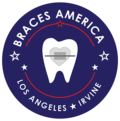Orthodontic treatment has evolved and increased in recent years for patients of all ages. With new technology and treatment options, Invisalign has increased in popularity as well. Many patients would wonder, which is the better treatment option for me? Dr. Nader Dayani is here to introduce the differences between braces and Invisalign orthodontic treatments.
Braces vs. Invisalign
Orthodontic treatments like braces or Invisalign aim to straighten teeth and enhance oral health. Braces consist of metal or ceramic brackets, depending on the type chosen by the patient, connected by a wire and secured with elastics. In contrast, Invisalign uses custom-made clear aligner trays instead of brackets and wires, making it the most aesthetically pleasing option.
Which Is Best For You? Pros and Cons of Each Treatment Option
Every patient’s case is unique, and depending on the severity of the issues, there are advantages and disadvantages to both braces and Invisalign.
Treatment
Braces typically offer the best solution for individuals experiencing crowding or requiring teeth rotation or shifting. Although traditional metal braces are most noticeable, there are other types of braces that are less noticeable and may be a great treatment option as well. Those with braces also have monthly visits to the orthodontist to have their wires and elastics changed.
Invisalign is an ideal treatment option if you do not have significant crowding and do not have a back tooth bite. If you are concerned about the visibility of orthodontic treatment, this is also a great option as well as it is very discrete. Please note that depending on the case, there may be a need for attachments, which are small clear bumps, placed on the teeth to create pressure to properly align the teeth. The office schedules visits at intervals of 4-6 weeks.

Comfort
Although some discomfort is inevitable with any orthodontic treatment, braces tend to be slightly more uncomfortable. During monthly orthodontist visits, the orthodontist uses a thicker wire to continue tightening and shifting the teeth, often causing soreness. In contrast, Invisalign does not cause sores and irritation inside the mouth like braces sometimes do.
Maintenance
Braces can be more challenging to maintain and require additional effort to ensure proper oral hygiene. The brackets and wires create tight spaces where food can easily become trapped. Orthodontists advise patients to avoid certain foods to prevent the brackets from detaching. Various tools, such as small brushes designed to clean between brackets, help remove food particles and plaque.
In contrast, Invisalign is easier to maintain. Patients remove the trays before eating, allowing them to brush and floss their teeth without any obstacles after each meal. This flexibility also means they can eat most foods without issue. Patients can effectively clean the alignment trays by rinsing them with warm water or using the Invisalign cleaning system.

The cost of braces can range from approximately $1,000 to $7,000, depending on the type of braces and the severity of the misalignment. Invisalign generally tends to be on the higher end of this range due to the lab costs involved in producing the custom trays.
Ultimately, the choice between braces and Invisalign depends on personal preference and the specific needs of your dental alignment. Both are excellent treatment options for teens and adults. To determine the best option for you, we recommend scheduling a free consultation with Braces America at www.bracesamerica.com or with Dr. Nader Dayani Orthodontics. Both Los Angeles and Irving locations are available for booking!

